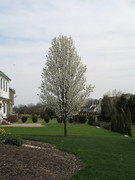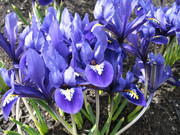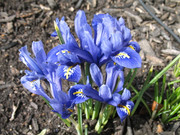Hardening off begins today as we're expecting several days of decent temperatures and cloudy, rainy weather. The plants are now outside enjoying a bit of sunlight and 70 degree weather as the clouds roll in.
I tend to try to choose a cloudy period as it's easier to adjust the plants to light if they don't need to adjust to full sun immediately. Even through a high cloud layer and putting them out late day, today's sunlight is enough to make them wilt a little bit.
As always, you can click on the image to embiggen it. In the larger version, the tall salvia in the back and the marigolds in the front are just a bit wilted. They'll recover as soon as the sun is off of them.

I'll bring them back in next Sunday when the weather turns colder again. They'll have three days to recover before going back out, and that will be very close to the proper time to plant.
The Cleveland pear tree is doing well this year. The tree below is now 8 years old and started as a 3' whip, but I've been encouraging it.
Again, click to embiggen.

The grass came roaring back post our very hard winter. As of this point, I haven't fed it yet, it doesn't require feeding until mid-May at the earliest.
As always...well, click it. You know the drill. The dead tree lying there is what remains of the Hinoki cypress I cut down over the weekend. I've already removed a fair chunk of the sticks and twigs, and chopped part of the trunks off. I'll have that cleaned up long before the gardens get planted.

Monday, April 28, 2014
Hardening Off
Saturday, April 26, 2014
Replacing the Hinoki Cypress
Our Hinoki cypress was unseated and tossed around by Hurricane Sandy back in October 2012. I knew the chances weren't good as the root systems were badly broken, but I reseated the tree and stanchioned it into place.
It did manage to survive until this winter, when the tree finally gave up.
Fortunately, I have a lilac I've kept dwarfed in another part of the garden that, frankly, really shouldn't be there. So today we dug up the cypress and replaced it with the lilac, which won't object to the transplanting and will enjoy that location just as much as it enjoyed its other one. It has the advantage that I don't have to dwarf it in its new home as well.
While transplanting, the root systems split into four, each with their own canes. Two bushes are now planted in other areas of the garden where they can also grow freely. And one went back into the location that the old bush came out of...oh well, I'll just dwarf it!
Transplanting a lilac is easy. Dig it up, take as much root mass as possible, and cut the canes back so they don't stress the roots too much. Place in new location, plant exactly as deeply as the place where it came out of, and water thoroughly post-transplant to settle the soil. In my case, I used a light mix of Miracle Gro to encourage the roots to grow back more quickly.
Lilacs strongly prefer near-neutral soil with good drainage and a high percentage of organic material. The organic material can be lower, however, and still grow a great lilac. They do demand at least 6 hours of sun per day (more is better) to bloom profusely.
Transplanted lilacs may bloom the next year if mature enough and if the root system you transplanted was large. Whips and suckers that are transplanted may need four to five years to bloom.
Friday, April 25, 2014
Holding Cold
Our average last frost date is April 20th, with the normal outside date May 15th.
This year, we look like we'll be receiving regular frosts and even a few light freezes through May 8th at the minimum, although the forecast that far out is unreliable at best. This could change at a moment's notice.
Still, I have plants downstairs that are starting to grow into the rafters (literally, the top shelf's lights are hung from the rafters, and the plants are now past the lights. The cleome and red salvia are particularly large, and so pot-bound in their little cells that they're starting to crawl out of them.
When this happens to you--and it probably will at some point--cease feeding and supply only water. You can also start the hardening off process under the lights at home.
First, put a fan on the plants to make the leaves and stems move. Shift the fan regularly to put it full strength on different flats. This will thicken the cuticles and stems, and train them to withstand winds. Although you can only get a ten to fifteen mile an hour equivalent wind on them, this will be sufficient to begin hardening them for outside life.
Second, run your hands over the top of the plants lightly once per day. Similarly, this will strengthen stems and leaves to withstand wind and other mechanical forces. It will also slow growth slightly as energy goes to thickening the skin and stem of the plant.
Third, let the plants wilt a bit before watering. This also strengthens the skin of the plant.
There's no substitute for sunlight and the plants will still need hardening off to the full light of the sun and the ultraviolet they haven't seen before. However, at the very least you can accomplish some of the hardening before you put the plants outside.
Tuesday, April 15, 2014
839
That was the final count on sprouted plants this year. While not a catchy number, it does mean I won't need much of anything from the local nursery this year.
Just for idle fun, here are approximate counts by species:
Zinnia: 370
Marigold: 180
Salvia farinacea: 75
Salvia splendens: 75
Celosia: 50
Cleome: 25
Easter Eggplant: 25
Melampodium: 25
Dahlia: 18
Saturday, April 12, 2014
Feeding the Thuja
I actually fed them late day Friday just before the showers came through.
Right now, this early in the season, I'm taking the easy way out. There's enough to do in the gardens that I don't have a vast amount of time to spend on smaller tasks.
So I wimped out and used some leftover 29-0-4 Vigoro fertilizer I had lying around. One small handful got thrown into the center of the bush to patter down and spread itself, while I spread more through where I know the roots go.
Since I was throwing things around anyway, I used about half Milorganite, half synthetic fertilizer to give a more sustained feed and add more iron to the mix.
Right now, the bushes are around 10-12 feet tall with a 5' diameter or so. Each bush received around 1/3 of a pound of 29-0-4, and 1/3 of a pound of Milorganite. The total instantly available nitrogen was approximately 0.1 pounds, with another 0.02 pounds of slowly available nitrogen.
I'll feed again in approximately two weeks, the fast way again. Once the gardens are in, I'll tend to use more Miracle Gro and Milorganite and table the 29-0-4 for the rest of the season. Feeding of the Thuja will continue through mid-August, at which point I stop to allow the bushes time to harden the new growth for winter.
Milk on the Lawn
Spring was delayed, but came on like gangbusters this year. It's currently around 70° F out there and absolutely perfect.
I spent most of the day putting down a bit over 1 tablespoon per thousand square feet of Prodiamine (Barricade), which will tend to deter weed sprout in the lawn and gardens for the next six months or so. I also treated the back patio and front walk to keep weeds from growing between the bricks. Effectiveness of the product is extremely good.
I washed that in with a gallon of milk spread over the lawn and gardens (the brick patio and walkway didn't get this, of course!), for about 8 ounces of milk per thousand. To that, I added around 4 ounces of humic acid and about 2 ounces of dissolved sodium laureth sulfate as a soil conditioner.
The sodium laureth sulfate helps soil bits conglomerate together instead of forming large plaques, increasing water penetration over time. The humic acid feeds the fungi in the lawn a little bit, assisting in water supply, nutrient supply, and general health.
The milk is...odd. It's not something I'd suggest adding unless your soil is tested and tuned fairly well, but it does seem to assist growth a little bit over a very long period of time. My idle guess is that an enzyme in there is similar enough to plant enzymes to unlock phosphorus from the soil matrix. But that's only a guess.
Over the next month, the milk will increasingly make the lawn a little greener, grow a little more strongly, and generally improve the look and durability. That advantage will maintain itself for the rest of the season.
Thursday, April 10, 2014
Too Late To Seed Now
As of today (which around here means plants will be put into the garden in around a month), it's now too late to start anything. If you didn't get there yet, you'll need to wait until next year to grow from seed.
The last of my plants went from the heater to the lights yesterday, and those were only 30 marigolds and zinnia that don't require much time. From here on out, I keep things watered, keep the lights on, and wait until they go out for hardening off around May fifth or so (give or take a few days).
While you could theoretically sneak in smaller, faster-developing marigolds like Janie or Durango if you plant immediately, they'll be very small when they go into your garden. That's not necessarily a disadvantage, although full growth and blooming will both be delayed.
Similarly, this is the wrong moment to seed your lawn (or feed it, for that matter). As of now, the new sprouts won't have time to develop good root systems before summer's heat hits. Feeding now simply taps the limited remaining carbohydrates from the grass roots and gives you lush growth--that won't survive the summer, and with tapped-out roots, there's no way for the plant to sustain the growth.
April is really a month to clean up, enjoy the blooming garden bulbs, and wait for the season to advance a bit. For me, garden planting will be around May 15th, with the lawn's first feeding following after the gardens have been planted.
Wednesday, April 9, 2014
More April Photos
While the planet just experienced its hottest month ever in January 2014, I was locked under a southern excursion of the polar vortex. That was unpleasant, but does have some positive side effects.
The Siberian iris, which have been limping along for years, actually got cold enough to fully set blossom. This year's blooms are fully colored, full-sized, and very pretty!
The photos below are close-ups, the actual plants are only about four to five inches tall total.
The purple iris (click to zoom in on the petal details):

The blue iris (ditto, the image is zoomable):

Thursday, April 3, 2014
April Lawn Photos
The snow has melted, and temperatures shot from the forties to the sixties pretty quickly. While the lawn definitely took a beating this winter, it should begin to recover shortly. Last year at this time we already had a fully green, growing lawn, this year growth hasn't resumed just yet. Soil temperatures are still a bit too cool for that.
You can see several patches of snow mold, which is unsurprising as the lawn spent most of the winter under snow and piles of snow from shoveling. This particular species of snow mold is pretty harmless, and the grass will recover with no issues. Those patches will simply be a bit slower.
As always, click on any image to embiggen it.

Bonus pic! The snow crocus just started to bloom as well, with this patch opening today. I missed capturing a native bee visiting the blooms by a few seconds. Again, these would normally blossom in early to mid March, but everything is late this year.
Click this one to embiggen and show off the stripes on the flowers!
